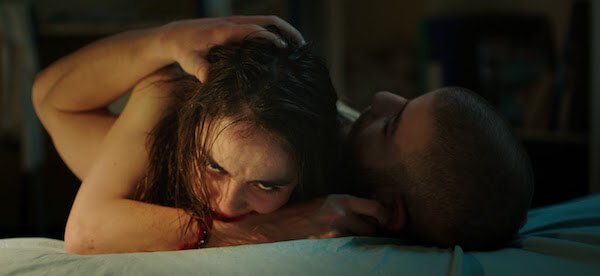Two teenage inmates in an Iranian prison. | THE CINEMA GUILD
The Iranian government likes to put up a façade of moral rectitude. As one might guess, this façade is paper-thin to actual Iranians, like the teenage girl prisoners profiled in Mehrdad Oskouei’s documentary “Starless Dreams.” I’ve never seen such a harsh and pitiless view of the Islamic Republic.
In an interview included in the film’s press kit, Oskouei expresses his gratitude for the fact that none of his films has been banned in Iran. Ironically, “Starless Dreams” goes much further in critiquing Iranian life than some films that have been banned in that country, like Jafar Panahi’s “Offside.” He must have earned some protection from the fact that he’s a documentarian: censorship of non-fiction in Iran is much less strict than the procedures narrative filmmakers have to go through for approval.
In a lesser director’s hands, “Starless Dreams” could have turned into tabloid trash –– the “women in prison” film, with inevitable lesbian overtones intended to please straight men, was a staple of exploitation cinema. That kind of B-movie has morphed into TV shows like “Lockup” and “Women Behind Bars.” But Oskouei achieves an intimacy never reached by such programs.
Mehrdad Oskouei offers harsh critique of Iranian society in stories of teenage inmates
He also refrains from portraying juvenile jail as Hell on Earth. His subjects get to draw comics, keep diaries, throw snowballs at each other and build snowmen, dance to Iranian pop music, and get HIV tests and information about the disease. When they see an imam, they deluge him with gender-based questions about Iran’s institutional sexism instead of listening quietly to his talk about the need for calm and peace in the country. “Starless Dreams” suggests that the real prison is Iranian family life.
The lessons “Starless Dreams” teaches about why girls wind up in jail apply equally to American culture. Almost every girl Oskouei interviews describes a wildly dysfunctional family. At least one parent is a drug addict, and most girls were both physically and sexually abused by a parent or other relative. This sets up a recipe for disaster: given such wonderful role models and so much pain, why not turn to meth or crack?
One of the film’s memorable subjects has named herself “651,” after the number of grams of cocaine she was busted carrying. Judging from what the other girls say, she might have received the death penalty if she were over 18.
The film begins in winter, and at first it seems fairly cheerful. The girls fool around like average teens who could be at boarding school. Then Oskouei films them getting fingerprinted and starts interviewing them. While he remains off-screen physically, his voice is often heard, and the girls refer to him as “Uncle Mehrdad” and discuss the fact that he makes a living as a college professor. The horrible tales of abuse begin and don’t let up for 20 minutes or so. When we reach the end of that portion of the film, it becomes far more observational and less reliant on formal interviews.
Oskouei films his subjects mostly in close-ups or medium shots, evoking a certain claustrophobia in the jail. At the same time, there’s a certain amount of freedom in that space, and the director never demonizes the guards or the women who work there.
“Starless Dreams” makes quite a contrast with the Chinese documentary “‘Til Madness Do Us Part,” which is set in a mental hospital for the involuntarily committed. That film presents its setting as horribly oppressive –– patients are given drugs and left with nothing to do all day but watch TV –– and makes it clear that every gram of freedom snatched by patients is very hard-won. It’s possible that Oskouei is sanitizing this jail, but judging from the girls’ stories, it seems safer than life on the streets or most of their homes.
“Uncle Mehrdad” has been working for 17 years, but “Starless Dreams” is his first feature, as well as his first film to get major attention on the festival and arthouse circuits. (An earlier, hour-long film about plastic surgery, “Nose, Iranian Style,” did get a small amount of festival play.) The great Iranian director Abbas Kiarostami, who made several documentaries and a larger body of work mixing fiction and non-fiction, passed away last year. After seeing “Starless Dreams,” I think the torch has been passed.
STARLESS DREAMS | Directed by Mehrdad Oskouei | The Cinema Guild | In Farsi with English subtitles | Opens Jan. 20 | Museum of the Moving Image, 36-01 35th Ave., Astoria | movingimage.us




































